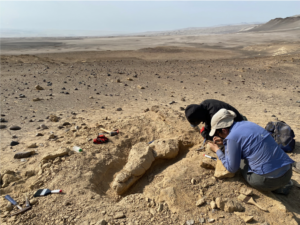Deciphering the dynamics of dissolved oxygen in the mid-depth ocean during the last deglaciation is essential to understand the influence of climate change on modern oxygen minimum zones (OMZs). Many paleo-
proxy records from the Eastern Pacific Ocean indicate an extension of oxygen depleted conditions during thedeglaciation but the degree of deoxygenation has not been quantified to date. The Peruvian OMZ, one of the largest OMZs in the world, is a key area to monitor such changes in near-bottom water oxygenation in relation to 20 changing climatic conditions. Here, we analysed the potential to use the composition of foraminiferal assemblages from the Peruvian OMZ as a quantitative redox-proxy. A multiple regression analysis was applied to a joint dataset of living (rose Bengal stained, fossilizable calcareous species) benthic foraminiferal distributions from the Peruvian continental margin. Bottom-water oxygen concentrations ([O2]BW) during sampling were used as dependant variable. The correlation was significant (R2 = 0.82; p<0.05) indicating that the foraminiferal 25 assemblages are rather governed by oxygen availability than by the deposition of particulate organic matter (R2=0.53; p=0.31). We applied the regression formula to four sediment cores from the northern part of the Peruvian OMZ between 3°S and 8°S and 600 m to 1250 m water depths; thereby recording oxygenation changes at the lower boundary of the Peruvian OMZ. Each core displayed a similar trend of decreasing oxygen levels since the Last Glacial Maximum (LGM). The overall [O2]BW change from the Last Glacial Maximum and the 30 Holocene was constrained to 30 μmol/kg at the lower boundary of the OMZ, whereas at shallower depths [O2]BW was relatively stable along the deglaciation. The deoxygenation trend was time-transgressive. It commenced at the southern core, and gradually spread to deeper waters and to the northernmost core location. This pattern indicates a gradual expansion of the OMZ during the last deglaciation, as a result of increasing surface
productivity in the Eastern Equatorial Pacific and decreasing advective oxygen supply to intermediate waters off
Peru.



